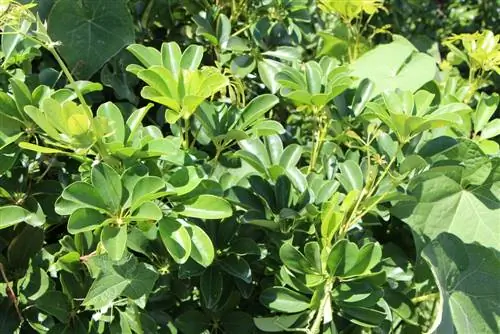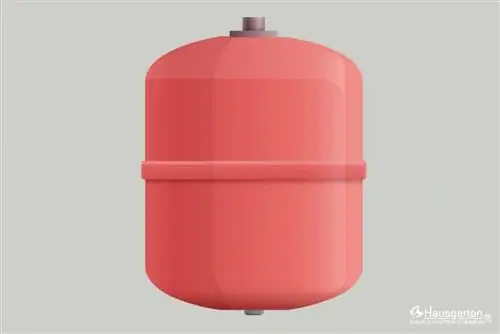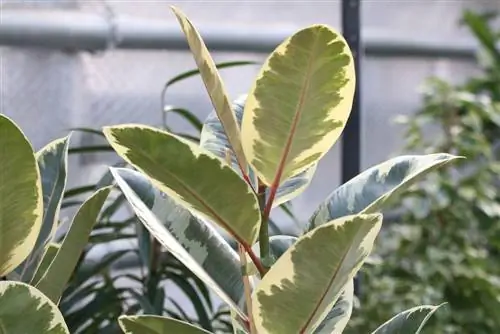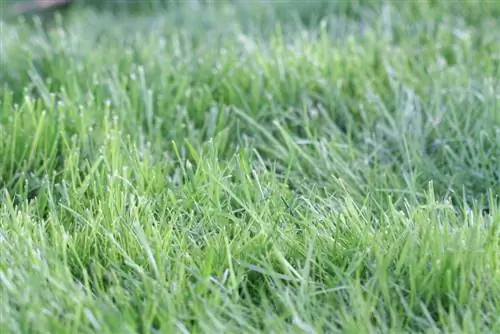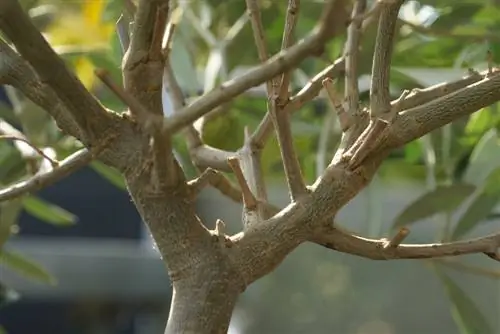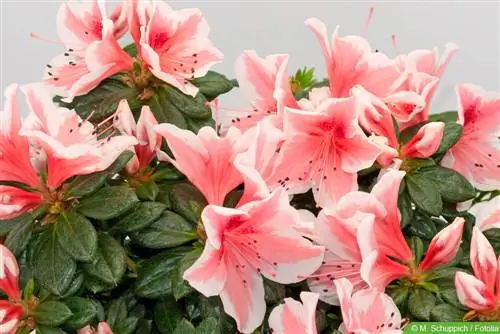- Author admin [email protected].
- Public 2023-12-17 03:39.
- Last modified 2025-01-24 12:45.
The Schefflera is also known colloquially as the Radiant Aralia and is a distinctive houseplant. That is why it has established itself as an ornamental plant in home and office spaces. Due to its hardy characteristics, the Schefflera is usually very easy to care for, however certain conditions and care errors can result in leaf loss. In this case, prompt relief measures are necessary, otherwise the radiation aralia can die.
Leaf loss
If leaves only fall off every now and then, then no one has to worry about it. Every plant loses more or fewer leaves over time, this is also the case with the Schefflera. After a few years it looks mostly bare, especially in the lower trunk area. The fact that the leaves only show at the top is a completely normal and age-related process. In older specimens, leaf loss is a natural process that can neither be prevented nor treated. This isn't a problem, but it doesn't look very appealing.
- Schefflera is generally robust and resilient
- Plant regularly sheds leaves
- Increased leaf loss is no longer normal
- Plant can die as a result
- Be sure to research the causes
- Reasons for leaf drop must be recognized in good time
- Afterwards, take appropriate countermeasures promptly
- This is how the houseplant can continue to exist
Temperature values
The Schefflera has certain demands on the temperature values; if these are too high or too low, then increased leaf loss occurs. For an even and straight growth habit, it is recommended to repeatedly turn the aralia in the direction of the light. Otherwise, it can happen that the leaf volume on the side of the plant facing away from the light decreases quite quickly. On the other hand, new leaves continue to form densely on the other side.
- Cannot tolerate cold
- Temperatures below 10-12° C cause the leaves to fall off
- Heat is also not tolerated
- Leaves burn under strong sun
- The ideal temperature is between 15-20° C
Root rot
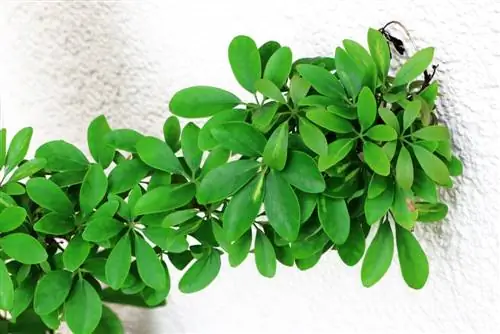
Although the Schefflera is very robust and therefore not particularly susceptible to diseases, the plant does tend to develop root rot. This is a harmful fungal infestation caused by too much moisture. This root rot is often the cause of intensive leaf drop, as the rotten roots can no longer supply the plant with water after a while. In the worst case, it can even lead to the complete death of the aralia. Therefore, the plant should be checked regularly. To do this, it is removed from the pot to check the substrate and roots. He althy roots are plump and feel firm; the substrate should not be too wet. If root rot is detected, quick countermeasures are required to save the plant.
- Too moist substrate causes root rot
- First the leaves turn yellow
- Afterwards most of the foliage falls off
- At the same time, a foul smell rises from the earth
- Wet and muddy roots are affected by root rot
- Roots and shoots turn black over time
- Never water Schefflera too much, avoid waterlogging at all costs
- Take the affected plant out of the pot and remove all of the substrate
- Also remove all rotten plant and root parts
- Then repot the plant into fresh substrate
Tip:
The excess water should never remain in the saucer for more than a few hours, so it should be emptied soon after watering.
drought
Just like waterlogging, the exact opposite can also cause increased leaf shedding. If the Schefflera suffers from constant drought, this permanently weakens its immune system. The plant originally comes from the Asian rainforests and therefore constantly needs a slightly moist substrate. In general, the substrate is allowed to dry out a little between watering sessions, but it must not dry out completely. In addition, it takes time for the plant to shed its leaves in dry conditions. If the soil is dry for more than two weeks, leaves will gradually begin to shed. If the soil dries out completely several times, this leads to brown edges on all the leaves. In addition, the plant sheds its already opened leaf buds.
- Leaves hanging limply on the trunk indicate a lack of water
- The leaves then fall off
- The cause is often the ball dryness
- Water abundantly to compensate for deficiencies
- Leaves stand up again after watering
- If the substrate is extremely dry, place in a water bath
- Leave it in the water for a few minutes
Note:
Since moist substrate is heavier than dry soil, you can tell by lifting the planter whether another watering session is due.
Site conditions
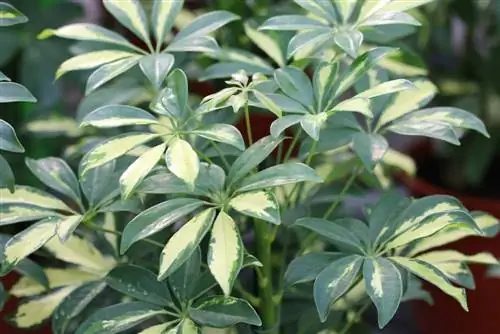
The site conditions are extremely important for the radiant aralia so that it can feel comfortable and grow he althily. If the Schefflera is dissatisfied with the location, the plant shows this by dropping its leaves. During the summer months, the plant can be moved outside, for example to the balcony or terrace. However, the summer residence should not be too sunny. Appropriate shading makes sense at this time of year, otherwise there is a risk of burns to the leaves. After purchase and after a change of location, the plant must be slowly acclimated to partially sunny location conditions. However, the Schefflera likes the gentler rays of sunshine in the morning and evening hours, these lead to the plant's shapely growth.
- Incorrect locations cause leaf loss
- Don't like location conditions that are too dark
- Can't tolerate drafts
- Bright to partially shaded place is ideal
- Avoid direct sunlight and midday heat
- The optimal location is without sun during the midday hours
- Otherwise ensure there is sufficient shade at midday
- Either close the curtains or lower the blinds
Pests
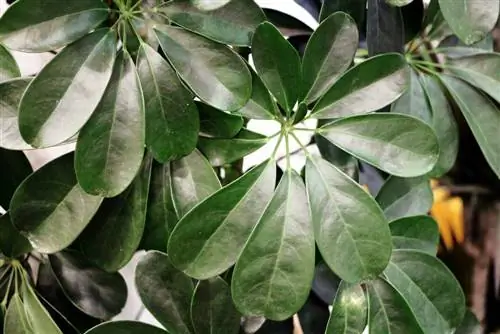
Despite its resilience, the Schefflera is susceptible to pest infestation. If mistakes are made during care and the site conditions are not right, various pests will quickly spread. These pests are often the cause of the radiant aralia dropping its leaves more frequently. In order to track down these culprits, the leaves and especially the undersides of the leaves must be closely inspected. The voracious insects gradually eat their way through the plant tissue and cause the leaves to drop. While mites and lice are familiar to most gardeners, many have not heard of thrips. The insect is tiny; with a body size of only 1-2 mm, it is quickly overlooked. It is also colloquially known as the thunderfly and is either yellow, dark brown or black in color.
- Susceptible to spider mites and thrips
- Infestations with aphids, scale insects and mealybugs are also common
- First isolate the infected plant to prevent it from spreading
- Shower with a sharp jet of water
- Always prefer natural home remedies
- Use antidote based on neem oil
- Alternatively, spray with a solution of soft soap and wash off
- Use the product repeatedly until the infestation is eliminated
- Conduct strict follow-up inspections
- Produce useful predators: these include lacewing larvae and predatory mites
Tip:
After the pests have been successfully controlled, appropriate measures must also be taken to maintain plant he alth. This includes the right care steps and a suitable location, otherwise a new pest infestation can quickly occur, which will kill the radiant aralia sooner or later.

